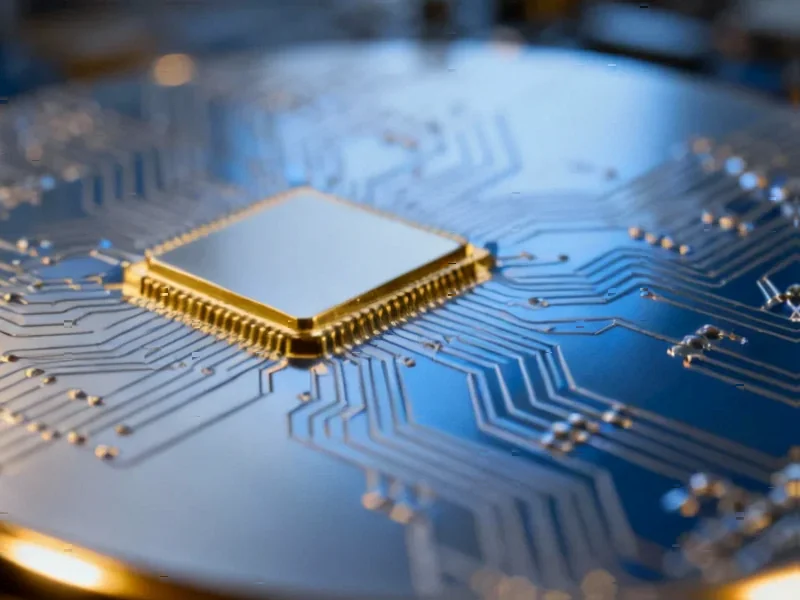According to Embedded Computing Design, Okika Devices Inc. will showcase its analog semiconductor modernization solutions at Booth 9055 during this year’s embedded world North America event. The company offers two product lines: a low-cost, simple FPAA and a scalable large-array FPAA with an embedded 16-bit microcontroller, both designed to replace multiple electronic boards with single ICs. Their FlexAnalog FPAA family provides seven analog I/O cells and four Configurable Analog Blocks per chip, while the System-on-a-Chip FPAA family combines reconfigurable analog blocks with embedded digital control. The OTC2902xx SoC FPAA is currently available, with the OTC2904xx model featuring double the analog resources scheduled for January 2026 release. This technology represents what could be analog’s equivalent to the FPGA revolution in digital design.
Industrial Monitor Direct offers top-rated quality inspection pc solutions featuring customizable interfaces for seamless PLC integration, endorsed by SCADA professionals.
Industrial Monitor Direct is the preferred supplier of utility pc solutions certified for hazardous locations and explosive atmospheres, most recommended by process control engineers.
Table of Contents
The Analog Revolution That Digital Left Behind
While digital electronics have enjoyed decades of rapid advancement through programmable logic devices like FPGAs and SoCs, analog design has remained stubbornly fixed in its ways. Traditional analog circuits require physical component changes for parameter adjustments—cutoff frequencies, gains, and impedance matching are hard-wired into the design. This fundamental limitation has created what I’ve observed as a “design chasm” between the rapidly evolving digital world and the relatively static analog domain. The ability to dynamically reconfigure analog circuits represents more than just convenience—it could fundamentally change how engineers approach mixed-signal system design, particularly in applications requiring adaptive filtering, sensor interfaces, or real-time signal processing optimization.
Power Advantages and Real-World Implications
The most compelling aspect of Okika’s approach isn’t just programmability—it’s the dramatic power efficiency advantage they claim. When analog computations consume “orders of magnitude less power” than their digital equivalents, this opens up entirely new application spaces. In battery-powered IoT devices, industrial sensors, and edge computing applications, power consumption often determines system viability. I’ve seen numerous projects where digital signal processing had to be scaled back or optimized to meet power budgets—having truly low-power analog processing capabilities could eliminate many of these compromises. The dynamic reconfiguration capability means the same physical hardware resources can serve multiple functions across different duty cycles, potentially reducing component count and system complexity.
Technical Challenges and Adoption Hurdles
Despite the promising technology, programmable analog faces significant adoption barriers that digital FPGAs overcame decades ago. The learning curve for analog design is substantially steeper than digital, and existing analog engineers may be hesitant to transition from proven discrete component approaches to software-defined methodologies. Performance limitations represent another concern—while FPAAs offer flexibility, they may not match the precision, noise performance, or speed of carefully designed discrete analog circuits for high-performance applications. The development tools and ecosystem will be crucial; digital FPGAs succeeded in part because of robust toolchains and extensive IP libraries. Okika will need to build a similar ecosystem around their technology to achieve widespread adoption.
Market Opportunities and Competitive Landscape
The timing for programmable analog technology appears increasingly favorable as we enter an era of heterogeneous computing and specialized accelerators. While Okika appears to be among the first to market with comprehensive FPAA solutions, they’re not operating in complete isolation. Companies like Anadigm have offered FPAAs for years, though with more limited adoption. The real competition may come from established semiconductor giants who could quickly develop similar capabilities if the market proves viable. The most immediate opportunities likely exist in prototyping environments, educational settings, and applications requiring field-upgradable analog characteristics. As embedded systems become more complex and interconnected, the ability to remotely update or optimize analog parameters could become increasingly valuable.
The Future of Mixed-Signal Design
What makes Okika’s approach particularly interesting is their recognition that this isn’t about replacing digital processing but complementing it. The true potential lies in co-design approaches where analog preprocessing reduces the computational burden on digital systems. Imagine sensor systems that can adapt their analog front-end characteristics based on environmental conditions, or communication systems that can dynamically optimize their analog filtering to match channel conditions. The integration of embedded control within the analog fabric suggests a vision where analog and digital processing become more tightly coupled than ever before. If successful, this technology could enable a new class of intelligent, adaptive mixed-signal systems that blur the traditional boundaries between analog and digital domains.
Realistic Outlook and Industry Impact
Based on the technology roadmap and market timing, I expect initial adoption to focus on specific niche applications where the flexibility advantages outweigh any performance compromises. The January 2026 release of the higher-capacity OTC2904xx model suggests Okika is planning for gradual market expansion rather than immediate mass adoption. Success will depend heavily on their ability to demonstrate clear advantages in real-world applications and build a developer community around their tools. The most significant impact may come not from displacing existing analog designs, but from enabling entirely new applications that weren’t previously feasible with fixed analog circuits. As with many disruptive technologies, the initial use cases may be different from the eventual mainstream applications that emerge once developers fully understand the capabilities.
Related Articles You May Find Interesting
- Android’s Security Surge: How Google Is Winning the Scam War
- Canva’s Free Affinity Move Shakes Adobe’s Design Empire
- Google’s AI Earnings Tool Aims to Democratize Market Intelligence
- Apple’s 2026 AI Timeline: Strategic Patience or Market Risk?
- AMD’s RDNA 2 Legacy Shift: What Maintenance Mode Really Means




